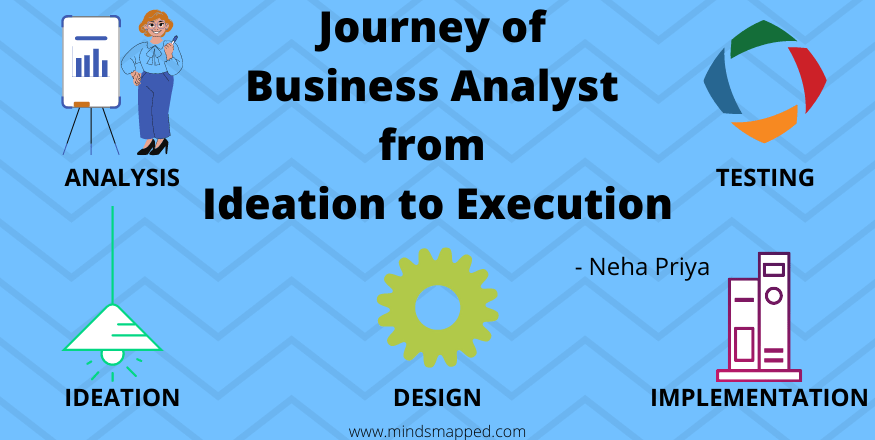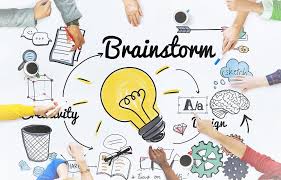
Journey of a Business Analyst from Ideation to Execution
Role of a Business Analyst in SDLC
The accelerating pace of technology and business change is hard and comes with significant investment, challenges, and risks. As Business Analysts, we continue to explore opportunities to identify how our client and corresponding technology capabilities can continually evolve. Also, be extended to deliver on the emerging needs of the business and its members.
The delivery of the structure of the digital project is either agile or waterfall. These deliveries are design-led and have a customer-focused environment. The Large-Scale Delivery offering focuses on enabling clients to successfully leverage an approach across typically complex, technology implementations. Project structures are often tailored to adopt elements from both waterfall and agile delivery approaches, to meet the specific requirements of the client, the technology, or the team. The benefits of agile are more in agile than waterfall. Business Analysts work at the intersection of customer, business, and technology to facilitate the delivery of the project along with other project roles.
As Business Analyst supports every stage of the program lifecycle, they aim to enable on time delivery of value-aligned to key business objectives. The highest priority for a BA is to satisfy the customer through early and continuous delivery of valuable software.
Throughout this journey, there are few basic questions that we address along the way:
- What technology initiatives are needed to enable the endorsed business strategy?
- How can the team optimize the performance, management, and cost-efficiency of the future digital experience?
- Are there any gaps and potential opportunities for better customer experience?
- How can our capability be positioned as a partner to the business, ensuring co-creation of value through increased trust, collaboration, and a shared vision?
Often, organizations seek assistance from the core team to conduct a technology maturity and capability assessment over a while. During this period, we engage widely across business areas, to explore technology capability and develop insights on how the client can improve their agility and responsiveness to business change and strategic business needs.
Business Analysts’ findings and recommendations are a key input to the team. At times, when the digital transformation is huge, the Business Analysts are engaged to assist with a complete overhaul of its enterprise systems.
Role of a Business Analyst in Inception Phase
The start of any digital project requires an understanding of the client and their customers. The business solution needs to support the overall objective and Business Analysts do this by using a customer-led approach. Facilitation of meetings is one of the key skills of Business Analysts that is put to use in this stage.
One such meeting is the Discovery Workshops. These are key stakeholder events to share an understanding of the solution and vision, where collaboration, exploration, and flexibility in a structured way allows the right solution to emerge incrementally and iteratively.
Discovery workshops must define scope, epics, features, Definition Of Ready, Definition Of Done, solution architecture, and foundational solution design. For a successful discovery workshop, it must have the right people present with set expectations and a common mindset. Multiple full/half-day sessions as required in the discovery phase. Preparation for the workshop is important and may include pre-reading, interviews, observations, story mapping, and exploration time.
As a result of the workshops, the majority of the work for the Business Analysts is decomposing epics and features to user stories to build a backlog for refinement. The aim is to validate assumptions about the vision, define MVP (Most Valuable Product), a roadmap with milestones, cadence, program releases, capacity, and velocity, and develop user stories for future backlog refinement. Backlog refinement is done to understand the high priority user stories to work on in preparation for future sprints so that Business Analysts know the value that needs to be delivered at the end of each sprint.
Business Analysts work closely with client stakeholders to consolidate current and future views on People, Process, and Technology that helps to define a target end state for the client’s capabilities and finally define a tangible and achievable roadmap over the agreed contract duration that details prioritized initiatives to deliver new capabilities. The decisions taken in this phase is critical in enabling the team to make informed, strategic decisions with regards to the roadmap of product capabilities for the future.
High-level activities include:
- Review the current state and the depth of the documentation
- Conduct a Technology Capability Assessment on the current state and target state capability.
- Develop findings report to consolidate detailed findings, recommendations, and a pragmatic roadmap in helping the client addressing priority uplift opportunities.
These processes will help the client to understand the current state capabilities and establish a high-level roadmap to reposition the new function as a catalyst for business growth and to keep members moving.
The above steps will help in developing an understanding of different requirements gathering techniques and relevant use of the various techniques for the client. Your BA skillset will guide you in identifying when to apply the appropriate business modeling technique to aid in the capture of the functional and non-functional requirements. Enhance the requirements gathering process with knowledge of client needs and long term vision and strategic goals.
Role of a Business Analyst in Elaboration Phase
A key step on this journey is a product roadmap that incorporates uplift of customer interaction and drives business growth across groups. To achieve success in this phase it is vital to have a plan which promotes a robust, efficient, and agile ICT environment; captures realistic and achievable goals, and incorporates innovative and contemporary solutions to support the continuous improvement of services.
As BA’s, the prime outcome of this phase is detailed user stories. User stories represent requirements, written in a customer-focused format, and each statement independently represents the value to be delivered to the client. Often user stories start as a high-level description of functionality and are refined and broken down to a lower level of granularity and a smaller slice of value before the story is taken into a sprint for the build. User Stories capture product functionality and serve to present the need and expectations of the end-user in business terms. They are used to give the programmer and tester a good understanding of what the requirement is. And thus, User Stories must be written in a way that they can be understood by a variety of readers. After User Stories have been created in collaboration with the Product Owners and often the technical team, they are then used for a variety of purposes as part of the project delivery process, such as sprint planning, progress tracking, estimation, and prioritization.
Acceptance criteria are the main essence of the user story. Acceptance Criteria can be considered as the quality and assurance checks that need to be fulfilled to ensure that the right product has been built. After a User Story has been built, and subsequent tests confirm that the Acceptance Criteria has been met, only then will the User Story be considered done.
In parallel to the requirement gathering, the technical solution also starts taking shape. Our role as a Business Analyst is also to facilitate the solution design process with business stakeholders, designers, and developers. We need to ensure the solution is well understood, documented, delivers on prioritized requirements, and ultimately approved by the business.
Business Analysts create Requirement Traceability Matrix (RTM) to ensure what developers build is aligned to business requirements and none of the requirements are missed. RTM document is continuously refined until the project is deployed and closed.
Similarly, Process Maps are also developed which illustrate the context of the business process to all stakeholders. It can be used to capture the current (as-is) state, end (to-be) state, interactions with systems, notifications, timer, or delays.
Role of a Business Analyst in Design Phase
The style or design of an application if the first thing that attracts a customer’s attention. Identifying the gap in the customer journey and rectifying it with a better design can be determined as one of the biggest wins for any client. Sometimes it’s challenging to get inspiration and design renovation ideas out of the box. This gap results in missed opportunities in cross-sell by having customers explore products related to their projects.
BA provides implementation, design, and technical expertise to determine how the client’s vision can be brought to life. Throughout this ‘design’ engagement, BA creates the customer UX, UI, functional/technical specifications, administrative workflows, wireframes, and define processes for efficiently creating assets at scale to cater to the client’s wide range of products.
They give the team a clear vision of the future for their planner and show them the value that can be derived from digitizing their product range. BA assists them to understand the new roles and processes that will need to be in place for them to truly ‘own the product’ in the long term.
Role of a Business Analyst in Implementation Phase
Business Analysts play an important role throughout project delivery and execution, which includes answering questions from the team, facilitating collaboration, and maintaining the flow of stories through the development cycle. Sprints follow a typical pattern from Sprint Planning, through the development of the product, to a Showcase and a Retrospective. Business Analysts often play a critical role in helping facilitate this cadence as the Scrum Master.
The key activities that BA can contribute to the implementation phase are by doing the following things:
- Contributing to the production of functional specification
- Create functional specifications, content and structure, and how to select different elements for different clients and projects
- Build knowledge of tools used to create functional specifications
- Builds understanding of the creation of content strategy, including input required, gathering of input, definition of overall vision, solution identification, governance issues, and structure of the final strategy
- Identifies opportunities to leverage existing templates and tools
- Identify how to deal with complexities that impact the solution design, agree upon solutions with the project team, and communicate these solutions to the client (with team leadership support).
- Able to identify challenges in the current project and recommend mitigation approaches.
These activities help the Business Analysts to be thorough with their work.
Role of a Business Analyst in Testing Phase
Once the solution is deployed in the implementation phase, then the testing phase kicks in. Business Analysts are important in any testing activity as they hold the most knowledge on the requirements and expected behavior of the system.
Traditional phases of testing will include:
- System Integration Testing (SIT) is to test full end to end integration between our system and other systems (which may have been developed as part of the same project/program or could already be live) to ensure that the user stories still work as expected
- User Acceptance Testing (UAT) is for actual business users to test the (integrated) solution, to validate and accept that it will work as expected
- Production Verification Testing (PVT) is to test the system in the Production environment as if it were life
- Regression Testing is to test existing systems will still function an expected when new functionalities are introduced
- Performance Testing is to ensure the solution can perform under load
- Security Testing is to ensure that the solution is not vulnerable to security threats
Typical testing related responsibilities of a BA during a Sprint or dedicated test phase may include:
- QA stories against AC / specs before passing to the test team for formal testing
- Answering questions from the test team
- Validate defects raised and confirm business priority
- Triage defects to the appropriate dev team
- Work with dev team and business to agree on resolution options
- Collation and communication of ETAs
Data Management is often not addressed with the sincerity that it deserves. When the client understands is severity, it is dealt with the right attention. This ensures there is accurate data, data controls, and make data more easily accessible and trusted. It does not only make sure the testing was done properly but also ensures the application is capable of handling the right volume of the real-time data in the future.
Final Thoughts on role of a BA in SDLC Lifecycle
Other than the set defined roles and responsibilities of a Business Analyst, many other initiatives require their attention. The continuous involvement of Business Analysts across all the different phases of the project helps in enriching their domain and platform knowledge.
I have shared my perspective on how business analysts are involved throughout the project lifecycle. I hope this gives a good start for those who are looking to understand the Business Analyst role in detail.



